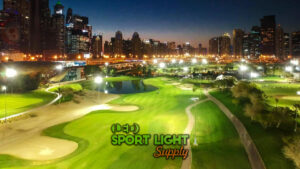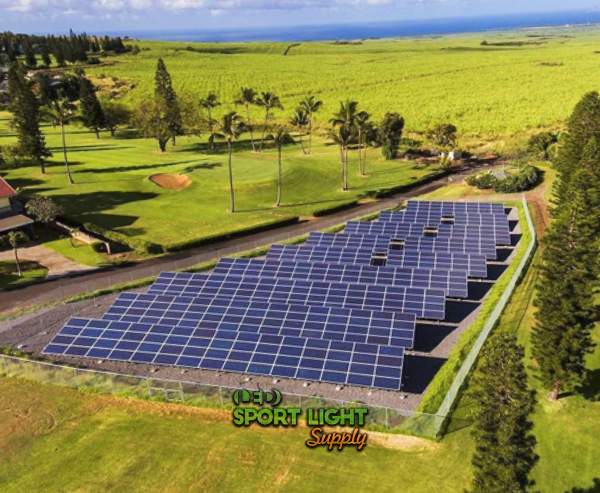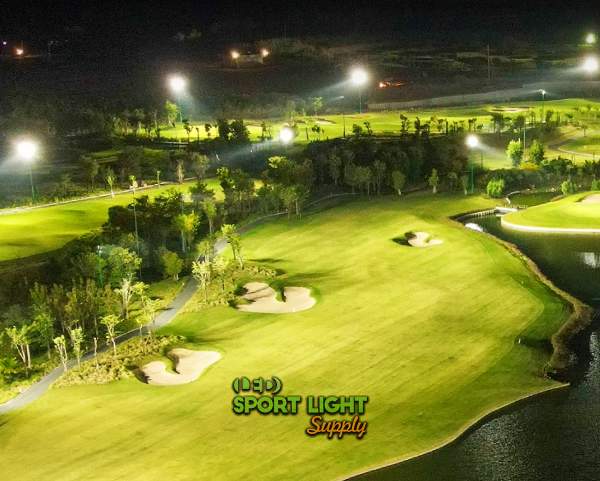
Golf courses, known for their expansive greens and scenic landscapes, require effective lighting solutions to accommodate players during low-light conditions. Traditional lighting systems can be energy-intensive and costly, especially for large areas like golf courses. Integrating solar-powered LED lighting offers a more sustainable approach that aligns with both economic and environmental goals. By leveraging solar technology, golf courses can reduce their dependence on conventional energy sources while enhancing the overall playing experience.
Table of Contents
Toggle One of the significant advantages of solar-powered LED lights is their ability to function independently of the electrical grid. This autonomy is especially beneficial for golf courses, where extensive wiring and infrastructure might be required to install traditional lights. By eliminating the need for costly trenching and wiring, solar lights can be installed more efficiently, reducing the upfront costs associated with lighting projects. Solar panels integrated into the fixtures or mounted on nearby posts capture sunlight throughout the day, converting it into energy stored in batteries. As dusk falls, this stored energy powers the LED lights, providing reliable illumination throughout the evening.
One of the significant advantages of solar-powered LED lights is their ability to function independently of the electrical grid. This autonomy is especially beneficial for golf courses, where extensive wiring and infrastructure might be required to install traditional lights. By eliminating the need for costly trenching and wiring, solar lights can be installed more efficiently, reducing the upfront costs associated with lighting projects. Solar panels integrated into the fixtures or mounted on nearby posts capture sunlight throughout the day, converting it into energy stored in batteries. As dusk falls, this stored energy powers the LED lights, providing reliable illumination throughout the evening.
The shift to solar-powered lighting systems translates into substantial long-term savings for golf course management. Conventional lighting systems incur ongoing costs related to electricity consumption, maintenance, and repairs. In contrast, solar LED lights draw from renewable energy, cutting down electricity bills significantly. Moreover, the reduced need for regular maintenance means fewer interruptions and lower labor costs, making solar lighting a cost-effective investment in the long run.
LED technology is known for its remarkable energy efficiency. Unlike traditional incandescent bulbs that consume large amounts of electricity and generate excessive heat, LEDs require only a fraction of the power to produce the same amount of light. This efficiency is particularly advantageous for solar-powered systems where energy needs to be conserved to operate throughout the night. By consuming less power, LED lights maximize the usage of stored solar energy, ensuring prolonged illumination even after cloudy days or shorter daylight hours.
Another advantage of LED lighting is its long lifespan. LED bulbs can last over 120,000 hours, which far exceeds the operational life of incandescent or fluorescent lights. This durability reduces the frequency of bulb replacements, minimizing maintenance efforts and costs. For golf courses, where lights are often installed in hard-to-reach areas, reducing maintenance can lead to significant time and cost savings. Additionally, the consistent performance of LEDs ensures reliable lighting, enhancing the overall experience for golfers during night events or early morning rounds.
 Golf courses require well-distributed lighting to enhance visibility and ensure safe play. The crisp, bright light emitted by LED fixtures provides uniform illumination across the course, which is essential for players navigating through pathways, greens, and hazard zones. Unlike other lighting technologies that can produce harsh glare, LEDs offer a softer, more focused light that minimizes eye strain and enhances visibility. This feature is particularly useful during evening tournaments or practice sessions, allowing golfers to see clearly without being distracted by glare.
Golf courses require well-distributed lighting to enhance visibility and ensure safe play. The crisp, bright light emitted by LED fixtures provides uniform illumination across the course, which is essential for players navigating through pathways, greens, and hazard zones. Unlike other lighting technologies that can produce harsh glare, LEDs offer a softer, more focused light that minimizes eye strain and enhances visibility. This feature is particularly useful during evening tournaments or practice sessions, allowing golfers to see clearly without being distracted by glare.
A well-lit golf course is not just about enhancing aesthetics; it also plays a crucial role in maintaining safety. Poor lighting can obscure obstacles, leading to potential injuries. By installing solar-powered LED lights strategically throughout the course, areas like pathways, tee boxes, and water hazards are adequately illuminated, reducing the risk of accidents. Additionally, improved visibility ensures that players, caddies, and staff can move around the course with confidence, even during twilight or pre-dawn hours.
The shift to solar-powered lighting aligns with the growing emphasis on sustainability within the sports industry. By harnessing renewable solar energy, golf courses can significantly reduce their carbon footprint. Unlike conventional lighting systems that rely on fossil fuels, solar-powered LEDs generate no greenhouse gas emissions, making them an eco-friendly choice. This move towards sustainability not only benefits the environment but also enhances the reputation of golf courses that prioritize green initiatives.
Golf courses that adopt solar lighting solutions can appeal to players who are increasingly aware of environmental issues. By demonstrating a commitment to reducing energy consumption and promoting sustainable practices, courses can attract patrons who value eco-friendly businesses. The use of solar-powered lights can become a unique selling point, setting a course apart from competitors and contributing to a positive brand image.
When integrating solar lighting into a golf course, careful planning is necessary to achieve optimal results. Key areas that benefit from illumination include pathways, greens, tee boxes, and hazard zones. Ensuring these critical areas are well-lit enhances both safety and gameplay. For instance, well-illuminated pathways allow players to navigate the course safely, while properly lit greens improve the visibility of shots and putts.
The design of solar lighting fixtures should not disrupt the natural beauty of the golf course. Fixtures can be selected to blend seamlessly with the landscape, preserving the aesthetic appeal of the grounds. Solar lights are available in various designs that can complement existing landscaping elements, ensuring that they do not detract from the overall visual experience. Thoughtful placement can also minimize shadows and glare, creating a more pleasant atmosphere for evening play.
Golf courses are exposed to diverse weather conditions throughout the year, from intense summer heat to heavy rain and snow. The durability of solar LED fixtures is a crucial factor in ensuring their longevity. High-quality solar lights are designed to be weather-resistant, with waterproof and rust-resistant features that enable them to withstand harsh environments. These fixtures are often constructed with materials that resist corrosion, ensuring that they remain functional despite exposure to moisture or extreme temperatures.
Solar LED lights are engineered to operate efficiently in a range of temperatures, ensuring consistent performance throughout the year. For golf courses in regions with fluctuating weather, investing in durable solar lights can lead to fewer replacements and lower maintenance costs. This reliability ensures that the course remains well-lit, regardless of seasonal changes, enhancing the playing experience for patrons and reducing downtime for maintenance.
While the initial costs of installing solar-powered LED systems may be higher than conventional lighting solutions, the long-term savings are substantial. Solar lighting eliminates the need for costly electrical installations and reduces energy bills significantly over time. Additionally, with the extended lifespan of LED bulbs and the reduced frequency of maintenance, golf courses can achieve a favorable return on investment within a few years.
Maintaining solar lighting systems is relatively straightforward compared to traditional lighting setups. Routine checks involve inspecting the solar panels for debris, ensuring the batteries are operating correctly, and occasionally cleaning the fixtures to maintain optimal light output. These maintenance tasks are minimal and can be easily managed by existing groundskeeping staff, further reducing ongoing operational costs. By simplifying maintenance, golf courses can focus more on enhancing the player experience rather than dealing with frequent lighting repairs.
While the initial costs associated with solar-powered lighting systems may seem daunting, the long-term benefits far outweigh these upfront expenses. Many golf courses may hesitate to make the switch due to the perceived cost, but it is essential to consider the substantial savings over time in reduced energy bills and maintenance costs. Additionally, government incentives and tax credits for renewable energy projects can offset the initial expenses, making solar lighting a more feasible option.
Golf courses situated in regions with less consistent sunlight may have concerns about the effectiveness of solar-powered lighting. However, with advancements in solar panel technology and energy storage systems, even courses in areas with variable weather conditions can benefit from solar lighting. The use of high-efficiency panels and batteries ensures that enough energy is captured and stored to meet the lighting needs of the course, even during cloudy or winter months.
For golf courses located in regions prone to severe weather, durability is a primary consideration. Solar-powered lighting systems designed for outdoor use are now equipped with features like waterproofing, UV-resistant coatings, and rustproof materials. These enhancements ensure that the fixtures can withstand extreme conditions, providing reliable lighting throughout the year. Selecting high-quality solar lights with robust construction is essential for courses looking to minimize replacements and maintain consistent illumination.
The integration of solar-powered LED lighting in golf courses is more than just a trend; it represents a shift towards a more sustainable and cost-efficient approach to facility management. By harnessing the power of the sun, golf courses can achieve a harmonious balance between operational efficiency and environmental stewardship. The reduced dependence on non-renewable energy sources, combined with the enhanced player experience, positions solar lighting as a strategic investment for the future.
Drop us a line to receive a free lighting design